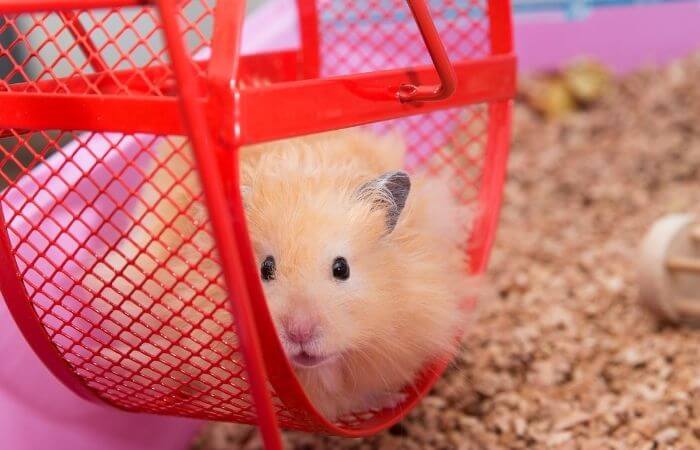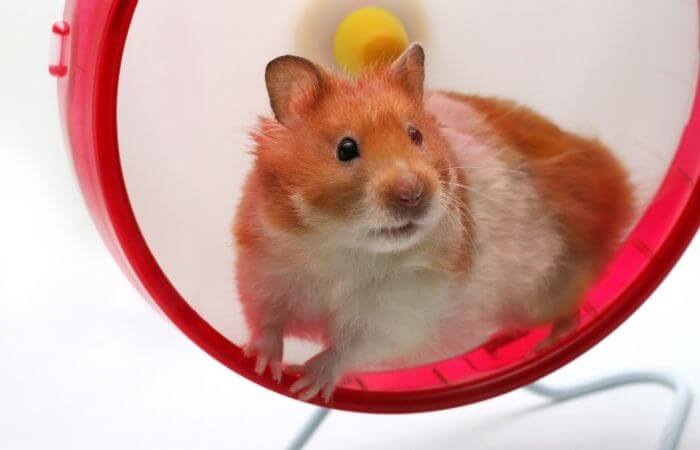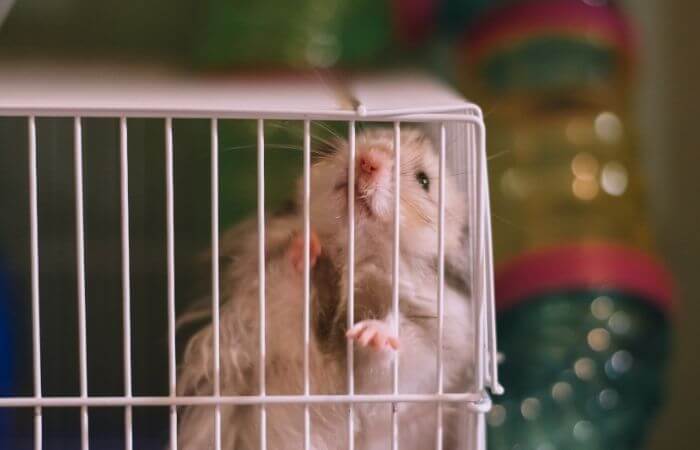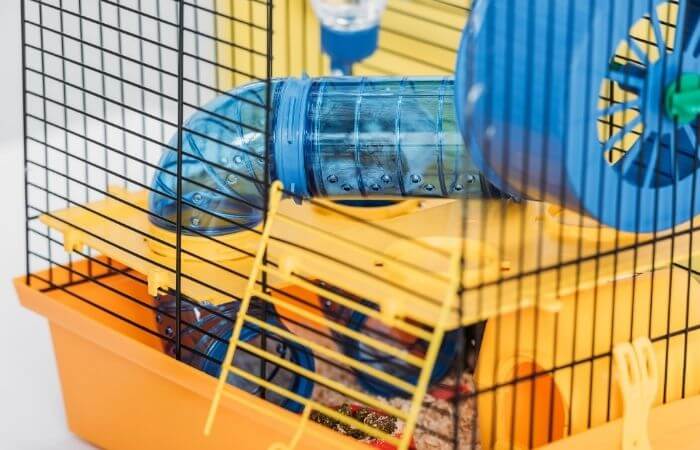Hamsters are generally quiet pets, yet the one common complaint that many owners have with them is the noise their wheels make.
Hamsters are nocturnal animals who tend to be very active during the night.

A squeaking hamster wheel when you are trying to sleep is not ideal, here are 7 methods you can use to quieten your hamster’s wheel:
1. Oil The Wheel
Squeaky wheels are caused by the friction created when a plastic wheel spins noisily on its axel.
This is easy to fix.
Just lubricate the wheel to reduce friction and therefore noise.
First get hold of some:
- Cotton Wool
- Vegetable Oil (Other oils will work however vegetable oil is non-toxic so won’t harm your hamster) or butter.
Then follow these steps:
- Remove the hamster wheel from the cage.
- Take it apart, making sure to remove the axel fully from the wheel.
- Put a small amount of vegetable oil onto the cotton wool.
- Rub the oil all over the axel until it is thoroughly covered.
- Reassemble the wheel.
- Put it back in its cage.
- Repeat this every fortnight (the regular use the wheel gets means that frequent relubrication will be required).
…job done.
Hopefully, the squeaking will bother you no more, if not then keep reading for more options.
2. Get A Better Wheel

Cheap plastic hamster wheels tend to be the worst culprits when it comes to squeaking.
Upgrading the wheel is a quick and easy solution to your hamster wheel noise problem.
Metal wheels tend to be less squeaky however they do make a louder rumbling noise when in use as they are heavier.
As a general rule more expensive freestanding hamster wheels will be more finely tuned and less prone to squeaking.
Cheaper ones will squeak more.
These days there are even purpose-made quiet hamster wheels such as the one below which are a great option:
- Specially designed for quiet spinning
- Encourages healthy exercise
- 10" diameter
3. Move The Hamster Wheel
If your hamster wheel clips onto the frame of your hamster cage then the angle which it is clipped on at can contribute to the squeaking.
Adjust the angle of the wheel slightly and see if this makes any difference, often a simple adjustment can completely eradicate the noise.
Ideally, the wheel should be aligned parallel with the cage, this will minimize unnecessary stress on the axel reducing noise.
4. Move The Cage
If you still haven’t had any luck then moving the hamster’s cage to somewhere where it will not disturb anyone is an obvious and highly effective option.

The living room and bathroom are good places to keep a noisy hamster, bedrooms aren’t!
If your child really want to keep their hamster in their bedroom then moving the cage out of there during the night is a good option.
Don’t put your hamsters cage in a noisy area with high footfall and different disturbances (next to the TV is not a good place for your hamster’s cage to go).
They need somewhere relatively quiet where they can sleep peacefully during the day.
5. Encourage Your Hamster To Exercise In Other Ways
For most hamsters their wheel is their main form of exercise.
Hamsters are energetic creatures.
They can run as far as 9km (5.5 miles) a night – a huge distance for such a small creature!
If they decide to travel that full distance on their wheel its going to be a long noisy night for you.

Ensuring that your hamster has other options to get exercise is a great way to minimise the amount of time that they will spend on their wheel.
Building a network of tunnels for your hamster to explore is a great way of allowing them to burn energy climbing and running long distances (your tunnels can be as elaborate and long as you want) which will make them more tired so they will therefore use the wheel less.
Check out this video of a monster hamster tunnel that these guys built for some inspiration.
6. Remove The Wheel
If you have no other options then a good short term solution is to take the wheel out of the cage when you go to bed.
Encourage your hamster to use the wheel as much as possible during the evening by placing food on it.
When it’s time to go to bed simply take it out.
This isn’t an ideal long-term solution as your hamster will not get enough exercise which will negatively impact their health but in the short term it is effective and will allow you to sleep undisturbed.
7. Soundproof The Cage
Purpose made hamster cage covers are hard to find as cages come in a wide variety of different shapes and sizes.
A good idea is to wrap the cage in a thick acoustic blanket that will help dampen the sound made inside the cage.
Make sure that you don’t completely cover the cage as your hamster needs fresh air and light.
You could also double or triple wrap the cage in breathable fabric for a similar effect.
Important factors when choosing a hamster cage cover:
- Breathable material
- Machine washable
- Doesn’t completely blackout the crate
You can also keep the cage on a soft padded matt, this will help dampen wheel vibrations from traveling through your furniture.
Conclusion
If none of these tricks work for you on their own try combining a few.
A new freshly oiled wheel, in a different room, with insulation around it should be pretty hard to hear!
As an Amazon Associate I may earn a small fee from qualifying purchases at no extra cost to you. This helps us run the site, so thanks for your support!
